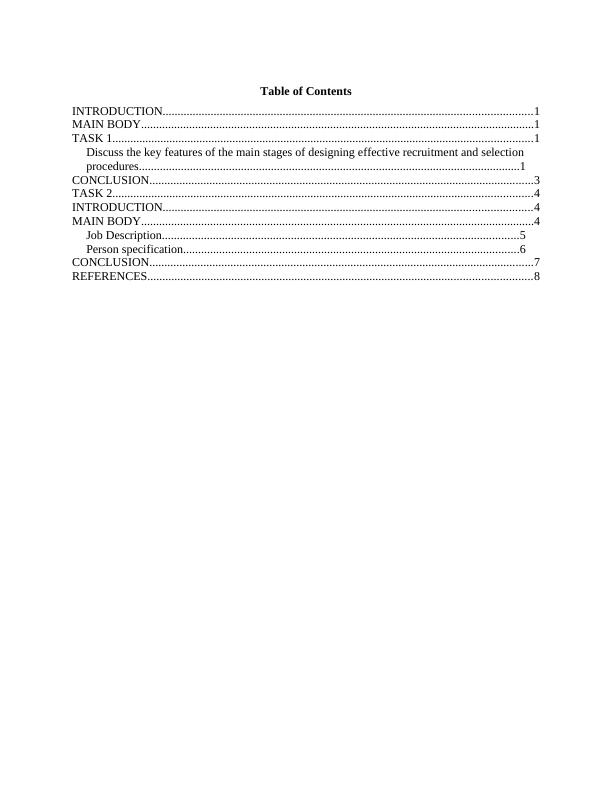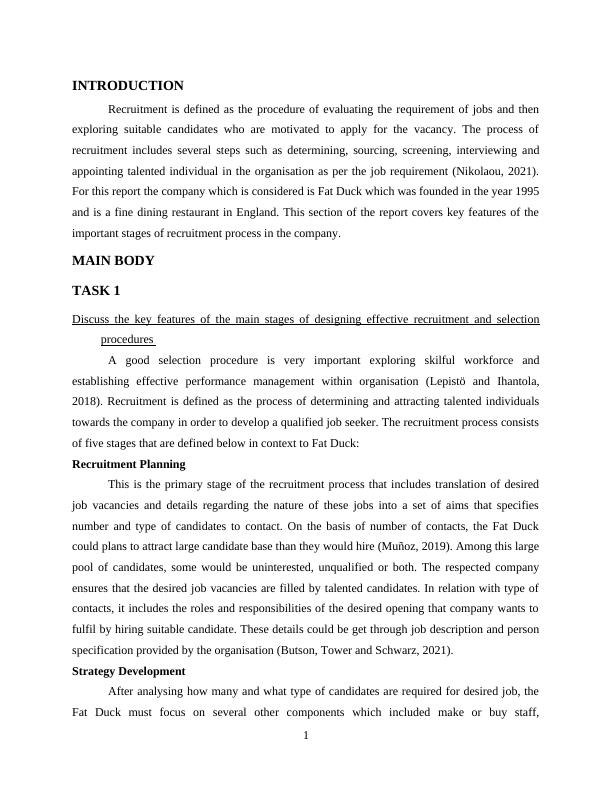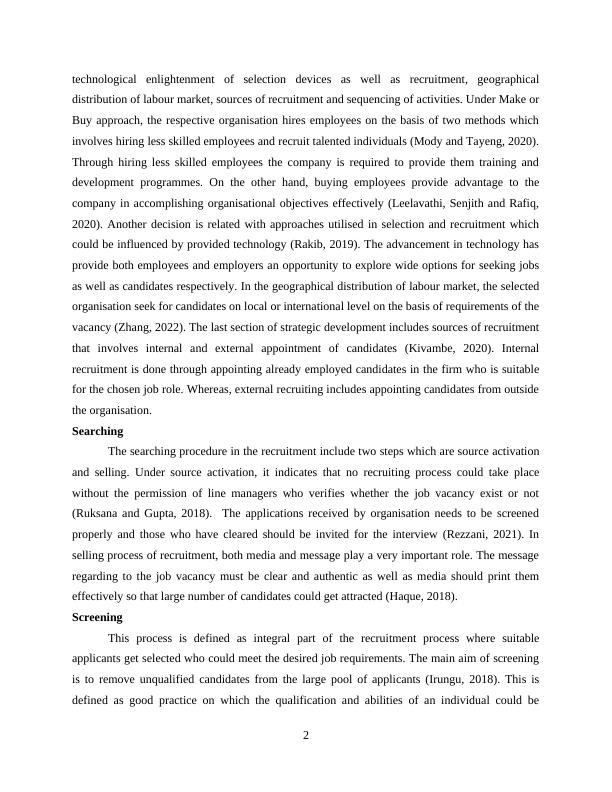Designing Effective Recruitment and Selection Procedures: A Case Study of Fat Duck
Added on 2023-06-13
11 Pages3606 Words454 Views
Individual Portfolio

Table of Contents
INTRODUCTION...........................................................................................................................1
MAIN BODY...................................................................................................................................1
TASK 1............................................................................................................................................1
Discuss the key features of the main stages of designing effective recruitment and selection
procedures...............................................................................................................................1
CONCLUSION................................................................................................................................3
TASK 2............................................................................................................................................4
INTRODUCTION...........................................................................................................................4
MAIN BODY...................................................................................................................................4
Job Description.......................................................................................................................5
Person specification................................................................................................................6
CONCLUSION................................................................................................................................7
REFERENCES................................................................................................................................8
INTRODUCTION...........................................................................................................................1
MAIN BODY...................................................................................................................................1
TASK 1............................................................................................................................................1
Discuss the key features of the main stages of designing effective recruitment and selection
procedures...............................................................................................................................1
CONCLUSION................................................................................................................................3
TASK 2............................................................................................................................................4
INTRODUCTION...........................................................................................................................4
MAIN BODY...................................................................................................................................4
Job Description.......................................................................................................................5
Person specification................................................................................................................6
CONCLUSION................................................................................................................................7
REFERENCES................................................................................................................................8

INTRODUCTION
Recruitment is defined as the procedure of evaluating the requirement of jobs and then
exploring suitable candidates who are motivated to apply for the vacancy. The process of
recruitment includes several steps such as determining, sourcing, screening, interviewing and
appointing talented individual in the organisation as per the job requirement (Nikolaou, 2021).
For this report the company which is considered is Fat Duck which was founded in the year 1995
and is a fine dining restaurant in England. This section of the report covers key features of the
important stages of recruitment process in the company.
MAIN BODY
TASK 1
Discuss the key features of the main stages of designing effective recruitment and selection
procedures
A good selection procedure is very important exploring skilful workforce and
establishing effective performance management within organisation (Lepistö and Ihantola,
2018). Recruitment is defined as the process of determining and attracting talented individuals
towards the company in order to develop a qualified job seeker. The recruitment process consists
of five stages that are defined below in context to Fat Duck:
Recruitment Planning
This is the primary stage of the recruitment process that includes translation of desired
job vacancies and details regarding the nature of these jobs into a set of aims that specifies
number and type of candidates to contact. On the basis of number of contacts, the Fat Duck
could plans to attract large candidate base than they would hire (Muñoz, 2019). Among this large
pool of candidates, some would be uninterested, unqualified or both. The respected company
ensures that the desired job vacancies are filled by talented candidates. In relation with type of
contacts, it includes the roles and responsibilities of the desired opening that company wants to
fulfil by hiring suitable candidate. These details could be get through job description and person
specification provided by the organisation (Butson, Tower and Schwarz, 2021).
Strategy Development
After analysing how many and what type of candidates are required for desired job, the
Fat Duck must focus on several other components which included make or buy staff,
1
Recruitment is defined as the procedure of evaluating the requirement of jobs and then
exploring suitable candidates who are motivated to apply for the vacancy. The process of
recruitment includes several steps such as determining, sourcing, screening, interviewing and
appointing talented individual in the organisation as per the job requirement (Nikolaou, 2021).
For this report the company which is considered is Fat Duck which was founded in the year 1995
and is a fine dining restaurant in England. This section of the report covers key features of the
important stages of recruitment process in the company.
MAIN BODY
TASK 1
Discuss the key features of the main stages of designing effective recruitment and selection
procedures
A good selection procedure is very important exploring skilful workforce and
establishing effective performance management within organisation (Lepistö and Ihantola,
2018). Recruitment is defined as the process of determining and attracting talented individuals
towards the company in order to develop a qualified job seeker. The recruitment process consists
of five stages that are defined below in context to Fat Duck:
Recruitment Planning
This is the primary stage of the recruitment process that includes translation of desired
job vacancies and details regarding the nature of these jobs into a set of aims that specifies
number and type of candidates to contact. On the basis of number of contacts, the Fat Duck
could plans to attract large candidate base than they would hire (Muñoz, 2019). Among this large
pool of candidates, some would be uninterested, unqualified or both. The respected company
ensures that the desired job vacancies are filled by talented candidates. In relation with type of
contacts, it includes the roles and responsibilities of the desired opening that company wants to
fulfil by hiring suitable candidate. These details could be get through job description and person
specification provided by the organisation (Butson, Tower and Schwarz, 2021).
Strategy Development
After analysing how many and what type of candidates are required for desired job, the
Fat Duck must focus on several other components which included make or buy staff,
1

technological enlightenment of selection devices as well as recruitment, geographical
distribution of labour market, sources of recruitment and sequencing of activities. Under Make or
Buy approach, the respective organisation hires employees on the basis of two methods which
involves hiring less skilled employees and recruit talented individuals (Mody and Tayeng, 2020).
Through hiring less skilled employees the company is required to provide them training and
development programmes. On the other hand, buying employees provide advantage to the
company in accomplishing organisational objectives effectively (Leelavathi, Senjith and Rafiq,
2020). Another decision is related with approaches utilised in selection and recruitment which
could be influenced by provided technology (Rakib, 2019). The advancement in technology has
provide both employees and employers an opportunity to explore wide options for seeking jobs
as well as candidates respectively. In the geographical distribution of labour market, the selected
organisation seek for candidates on local or international level on the basis of requirements of the
vacancy (Zhang, 2022). The last section of strategic development includes sources of recruitment
that involves internal and external appointment of candidates (Kivambe, 2020). Internal
recruitment is done through appointing already employed candidates in the firm who is suitable
for the chosen job role. Whereas, external recruiting includes appointing candidates from outside
the organisation.
Searching
The searching procedure in the recruitment include two steps which are source activation
and selling. Under source activation, it indicates that no recruiting process could take place
without the permission of line managers who verifies whether the job vacancy exist or not
(Ruksana and Gupta, 2018). The applications received by organisation needs to be screened
properly and those who have cleared should be invited for the interview (Rezzani, 2021). In
selling process of recruitment, both media and message play a very important role. The message
regarding to the job vacancy must be clear and authentic as well as media should print them
effectively so that large number of candidates could get attracted (Haque, 2018).
Screening
This process is defined as integral part of the recruitment process where suitable
applicants get selected who could meet the desired job requirements. The main aim of screening
is to remove unqualified candidates from the large pool of applicants (Irungu, 2018). This is
defined as good practice on which the qualification and abilities of an individual could be
2
distribution of labour market, sources of recruitment and sequencing of activities. Under Make or
Buy approach, the respective organisation hires employees on the basis of two methods which
involves hiring less skilled employees and recruit talented individuals (Mody and Tayeng, 2020).
Through hiring less skilled employees the company is required to provide them training and
development programmes. On the other hand, buying employees provide advantage to the
company in accomplishing organisational objectives effectively (Leelavathi, Senjith and Rafiq,
2020). Another decision is related with approaches utilised in selection and recruitment which
could be influenced by provided technology (Rakib, 2019). The advancement in technology has
provide both employees and employers an opportunity to explore wide options for seeking jobs
as well as candidates respectively. In the geographical distribution of labour market, the selected
organisation seek for candidates on local or international level on the basis of requirements of the
vacancy (Zhang, 2022). The last section of strategic development includes sources of recruitment
that involves internal and external appointment of candidates (Kivambe, 2020). Internal
recruitment is done through appointing already employed candidates in the firm who is suitable
for the chosen job role. Whereas, external recruiting includes appointing candidates from outside
the organisation.
Searching
The searching procedure in the recruitment include two steps which are source activation
and selling. Under source activation, it indicates that no recruiting process could take place
without the permission of line managers who verifies whether the job vacancy exist or not
(Ruksana and Gupta, 2018). The applications received by organisation needs to be screened
properly and those who have cleared should be invited for the interview (Rezzani, 2021). In
selling process of recruitment, both media and message play a very important role. The message
regarding to the job vacancy must be clear and authentic as well as media should print them
effectively so that large number of candidates could get attracted (Haque, 2018).
Screening
This process is defined as integral part of the recruitment process where suitable
applicants get selected who could meet the desired job requirements. The main aim of screening
is to remove unqualified candidates from the large pool of applicants (Irungu, 2018). This is
defined as good practice on which the qualification and abilities of an individual could be
2

End of preview
Want to access all the pages? Upload your documents or become a member.
Related Documents
Effectiveness of Recruitment and Selection Strategies in Tescolg...
|14
|3951
|27
Recruitment and Selection Practiceslg...
|7
|1913
|161
Assignment on Managing People in Organizationslg...
|15
|3343
|317
Effectiveness of Recruitment and Selection Strategies in TESCOlg...
|13
|3542
|89
Individual Recruitment and Selection: A Case Study of Sunrise Natural Foodlg...
|11
|776
|68
Recruitment and Selection Practiceslg...
|9
|1729
|83
